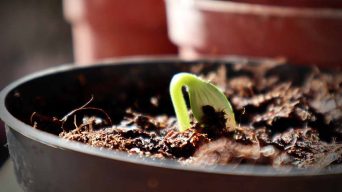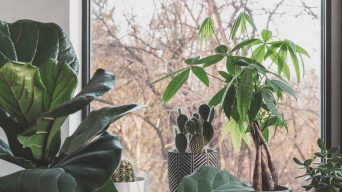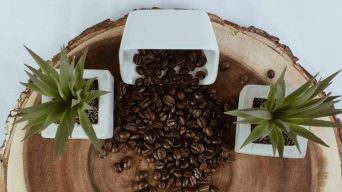To keep indoor plants warm in winter, move them to a warmer place, create a greenhouse environment for seedlings and young plants, use grow lights at night, invest in a heater, and avoid cold drafts. Heat mats and bubble wrap can also be used for added warmth.
Keeping your indoor plants warm and thriving can be challenging as winter approaches.
Chilly temperatures, reduced sunlight, and low humidity levels can stress your beloved houseplants.
However, with the proper care and attention, it’s possible to maintain their health through these colder months.
In this comprehensive guide, we’ll share easy tips and tricks for keeping your indoor plants cozy during winter so that they continue to flourish year-round.
Read on to discover how you can protect your green friends from harsh winter conditions!
Why Do Indoor Plants Need Extra Care In Winter?
Indoor plants are an excellent way to bring some greenery and life into your home.
Still, they require proper care and attention, especially during winter.
Here we will explore why indoor plants need extra care in winter, including the impact of low sunlight, humidity, and temperature on their growth and well-being.
Understanding these factors can help your indoor plants thrive throughout the colder months and beyond.
Understanding The Impact Of Lack Of Sunlight, Low Humidity, And Cold Temperatures
During the winter months, indoor plants often struggle to thrive due to reduced sunlight, low humidity, and cold temperatures.
As daylight hours decrease and the sun’s angle shifts, plants receive significantly less light than they do in other seasons.
This shortage of light can lead to poor growth and may even cause some plants to enter dormancy prematurely.
Low humidity levels indoors are another common issue during winter. When we turn on our heating systems, they dry the air around us.
Without adequate moisture in their environment, indoor plants may suffer from issues such as wilting leaves or inhibited growth.
Cold temperatures present additional challenges for keeping indoor plants warm during winter.
Even though your home may be heated overall, certain areas (near windows or doors) may still be colder than others – exposing sensitive tropical plants that prefer warmer climates to chilly drafts or low room temperatures, which might stunt their growth or kill them altogether.
For example, a potted plant placed right next to a drafty window could experience drastic fluctuations in temperature throughout the day due primarily to heat loss through glass panes and sudden blasts of cool air coming open doorways nearby.
Easy Ways To Keep Indoor Plants Warm In Winter
Winter can be a challenging time for indoor plants as the drop in temperature can be detrimental to their growth and overall health.
Fortunately, there are several easy ways to keep your indoor plants warm during the colder months.
Here we will explore some practical methods, such as using a heating mat, providing insulation with plastic domes or cloths, and using materials like bubble wrap or thermal foil to trap heat.
By implementing these techniques, you can ensure your plants thrive in winter.
1. Using A Heating Mat To Provide Warmth From Below
A heating mat is a great way to provide warmth from below for indoor plants during the winter.
This device helps keep your plant’s soil at a consistent temperature, promoting healthy growth and preventing root rot.
It’s beneficial if you’re starting seeds or propagating cuttings in the colder months.
To use a heating mat, place it under your pot and plug it in. Make sure to follow the manufacturer’s instructions for safe use.
Keep an eye on the temperature of the soil and adjust accordingly, as different plants have varying heat requirements.
By providing warmth from below, these mats are an easy solution to help keep indoor plants warm during winter.
Incorporating a heating mat into your plant care routine can make all the difference in keeping your plants happy and healthy through the colder months.
2. Covering Plants With Plastic Domes Or Cloths For Insulation
Another great way to keep your indoor plants warm during winter is by covering them with plastic domes or cloths.
This technique provides insulation by trapping heat and moisture around the plant, creating a mini greenhouse effect.
You can use clear plastic domes designed explicitly for this purpose or cover your plants with a cloth that allows some light to pass through.
Just be sure not to completely seal off the plant, as it still needs fresh air circulation.
Also, make sure not to leave the dome on too long, as excess moisture buildup can lead to fungal growth and other plant diseases.
3. Insulating With Bubble Wrap Or Thermal Foil To Trap Heat
One effective method to keep indoor plants warm during winter is by insulating them with bubble wrap or thermal foil.
These materials trap heat and create an extra layer of warmth around the plant, protecting it from cold air.
To use this technique, wrap the plant pot snugly with a layer of bubble wrap or thermal foil, ensuring no gaps are left open.
Use tape if necessary to secure the insulation in place.
Insulating your indoor plants can be particularly helpful for tropical species that require consistent warmth and humidity levels to thrive.
It’s also a cost-effective solution compared to investing in more expensive heating systems like space heaters or grow lights.
Remember to monitor the temperature and moisture levels regularly while using this method, as excessive insulation can cause overheating or fungal growth on the leaves.
4. Providing Extra Heat With A Space Heater
Another easy way to keep indoor plants warm during the winter is using a space heater.
While this method can be effective, it’s important to use caution and not overheat your plants.
Make sure to place the heater at a safe distance from your plants and monitor the temperature regularly.
Using an adjustable thermostat can also help regulate the heat output.
When using a space heater for indoor plants, ensure it is UL certified and has safety features like automatic shut-off in case of overheating or tipping over.
It’s also essential to avoid placing heating devices directly on top of or touching your plants, as they may burn or wilt due to excess heat.
With proper care and attention, you can efficiently use a space heater to provide additional warmth for your houseplants during winter.
5. Using A Humidifier To Increase Moisture Levels
Another easy way to care for indoor plants during the winter is by using a humidifier.
As temperatures drop, the air in your home becomes drier, which can cause harm to your plant’s leaves and stems.
A humidifier adds moisture to the air, creating ideal growing conditions for many houseplants.
To use a humidifier effectively, place it near your plants and turn it on regularly.
Some types of tropical plants require higher humidity levels than others, so be sure to research the specific needs of your houseplant before setting up the humidifier.
Additionally, monitor the humidifier and soil water levels to avoid overwatering or underwatering your plant.
Properly maintaining humidity levels is crucial for keeping indoor plants healthy during winter.
Studies have shown that some common houseplants are particularly adept at purifying dry indoor air when exposed to optimal humidity levels.
Tips For Maintaining Healthy Indoor Plants During The Winter
During winter, indoor plants can be challenging to maintain due to the dry air and lack of sunlight.
However, with a few tips and tricks, you can ensure your plants stay healthy throughout the colder months.
Here we will provide some essential tips for maintaining healthy indoor plants during the winter.
1. Adjusting Watering Frequency To Prevent Root Rot
Overwatering is a common mistake that can lead to root rot, especially during winter when indoor plants are not actively growing.
Adjusting watering frequency is crucial in preventing this problem.
Allow the soil to dry out slightly between waterings, and check the soil moisture level by sticking your finger about an inch deep into the soil.
It’s important not to let plants sit in standing water for too long.
Using drainage trays or pots with holes at the bottom can help prevent over-watering and ensure proper drainage.
Remember that different types of indoor plants have varying needs when it comes to watering, so be sure to research each plant’s specific requirements.
Adjusting the watering frequency and ensuring proper drainage will go a long way in keeping your indoor plants healthy throughout winter.
2. Avoiding Placing Plants Near Drafts And Cold Windows
One of the most crucial aspects of keeping your indoor plants alive during winter is avoiding placing them near cold drafts and windows.
When temperatures start to drop, it’s easy for plants to become damaged or even die from exposure to cold air.
Drafts can come from doors or windows that are opened regularly, so be sure to move your plants away from those areas.
Additionally, placing your plants near a window is a good idea since they need sunlight, but this can also expose them to cold air.
If you must place your plant near a window, consider adding extra insulation around the pot or using bubble wrap as an insulating layer between the plant and the glass surface.
Remember that different types of houseplants have varying temperature requirements and levels of hardiness in colder temperatures.
So be sure to research each plant’s needs before deciding where to place it in your home during the winter months.
3. Cleaning Leaves Regularly To Prevent Pests And Diseases
Cleaning your indoor plant’s leaves is essential to keeping them healthy during the winter months.
Dust, dirt, and debris can accumulate on the foliage, attracting pests and harboring diseases.
A soft cloth or sponge dipped in a solution of mild soap, and warm water should do the trick.
Wipe down each leaf gently to remove any buildup.
It’s also important to check for any signs of pests or diseases while cleaning your plant’s leaves.
Look for yellowing, wilting, or distorted leaves indicating infestation or illness.
Catching these issues early can prevent them from spreading throughout your entire plant collection.
Regularly cleaning your indoor plants’ leaves promotes their health and helps keep them looking beautiful all year round.
And remember to rinse off any leftover soap residue with clean water after cleaning!
4. Considering Using Grow Lights To Supplement Sunlight
It can be challenging to provide enough sunlight for your indoor plants in winter. That’s where grow lights come in handy.
They provide artificial light that mimics the sun’s rays and helps keep your houseplants healthy and green.
LEDs or fluorescent bulbs are two common types of grow lights.
LED lights last longer, use less energy, and emit less heat than fluorescent bulbs, making them an excellent choice for overwintering plants.
Supplemental lighting is especially helpful if you have large tropical plants or fruit trees indoors, which require more light than smaller succulents or cacti.
Remember to place your grow light close enough to the plant canopy without burning it and adjust its height so that all parts of the plant receive equal coverage.
Also, remember that too much exposure to natural and artificial light can damage leaves, so aim for a balance between the two light sources when caring for your indoor plants during winter.
Common Mistakes To Avoid When Keeping Indoor Plants Warm During Winter
To keep your indoor plants healthy during the winter, you must avoid common mistakes that can damage them.
Overheating your plants or using heating devices directly on them can cause harm.
Also, overwatering, neglecting to monitor temperature and moisture levels, and not providing enough light can lead to plant damage.
Following the tips below, you can ensure your indoor plants stay warm and healthy throughout the colder months.
1. Overheating Plants And Causing Damage
It’s important to keep indoor plants warm during winter, but it’s equally important not to overheat them.
Overheating can damage your plants’ leaves, roots, and overall health.
It’s easy to forget that just because we feel cold doesn’t mean our plants need excessive heat.
Avoid placing heating devices directly on or too close to the plant, as this can cause burns and overheating.
A common mistake people make is using a space heater without proper temperature control settings.
While space heaters are great for providing extra warmth in a room, they can also lead to overheating if left unchecked.
Keep an eye on your thermostat and invest in a heater with automatic temperature control features or set up timers for regular adjustments.
Remember, maintaining consistent temperatures between 65-75 degrees F (18 – 24 degrees C) is ideal for most houseplants during winter.
2. Overwatering And Drowning Plants
Overwatering is a common mistake regarding indoor plant care during winter.
As the temperature drops, plants’ growth slows down, requiring less water than usual.
Overwatering can lead to root rot and other fungal diseases that irreversibly harm your plants.
To avoid this, adjust your watering frequency to prevent over-saturating the soil.
Another way to keep indoor plants from drowning is by ensuring proper pot drainage.
If you notice standing water in the saucer or at the bottom of the pot, remove it promptly and adjust your watering schedule accordingly.
It’s also important not to water succulents and cacti as frequently as other houseplants since these species are adapted to dry conditions.
3. Using Heating Devices Directly On Plants And Causing Burns
It’s important to be careful when using heating devices on your indoor plants during winter.
Directly placing heaters or heat lamps too close to your plant can cause severe damage, such as burns and dryness.
This can lead to leaves turning yellow or brown and, in some cases, even death.
It’s best to place the heater nearby but not directly on top of the plant.
Another option is using a humidifier alongside a space heater, which can keep you and your plants warm without causing harm.
The humidifier will add moisture back into the air, helping combat dryness caused by indoor heating systems.
Final Thoughts
It’s important to remember that indoor plants need extra care during the colder months.
Lack of sunlight, low humidity, and cold temperatures can significantly impact their health.
However, with the proper precautions and extra effort, you can keep your indoor plants warm and thriving all winter.







